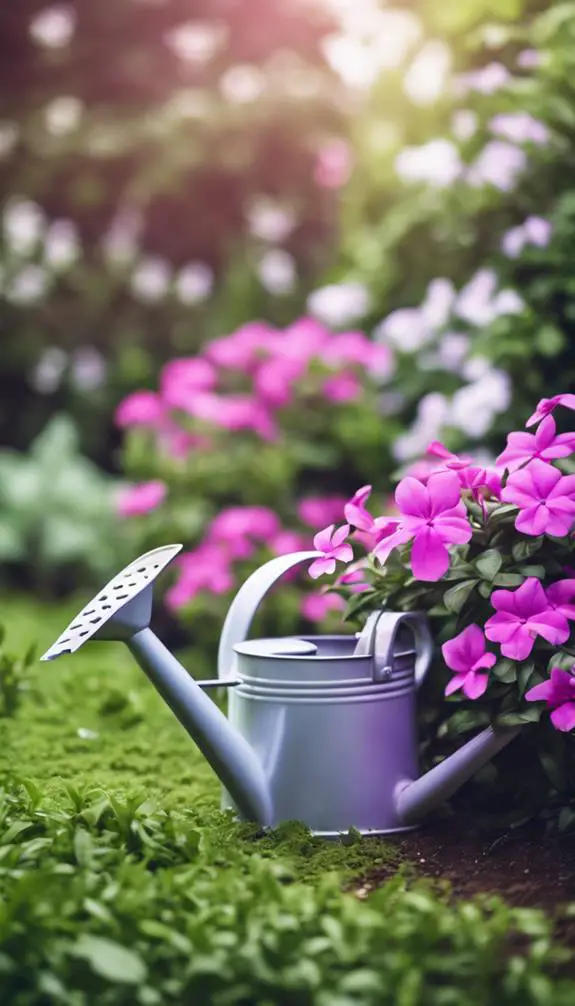You're about to set out on a rewarding journey: growing zucchini in your own backyard! As a beginner, it's vital to start with the basics. You'll need to choose the right variety, prepare the soil, and understand the sowing process. Get it right, and you'll be enjoying a bountiful harvest in no time. But, what makes a zucchini variety "right" for you, and how do you guarantee your soil is ready for planting? The answers to these questions will set you up for success – or failure.
Summary
- Choose a zucchini variety that suits your taste preferences, such as 'Black Beauty' or 'Patty Pan', and ensure it's suitable for your climate.
- Prepare the soil by mixing in a 2-inch layer of compost or manure to a depth of 8-10 inches, and test the pH level to ensure it's between 6.0 and 6.8.
- Sow seeds indoors 2-3 weeks before the last frost, using a high-quality seed starting mix and maintaining a soil temperature of 70-85°F (21-30°C) for ideal germination.
- Provide zucchini plants with at least six hours of direct sunlight daily, and water them when the top 2-3 inches of soil feel dry, typically every 2-3 days in hot summer weather.
- Fertilize zucchini plants with a balanced fertilizer at planting time, followed by high-phosphorus fertilizer to promote fruiting, and side-dress with nitrogen-rich fertilizer once plants are 12 inches tall.
Choosing the Right Zucchini Variety
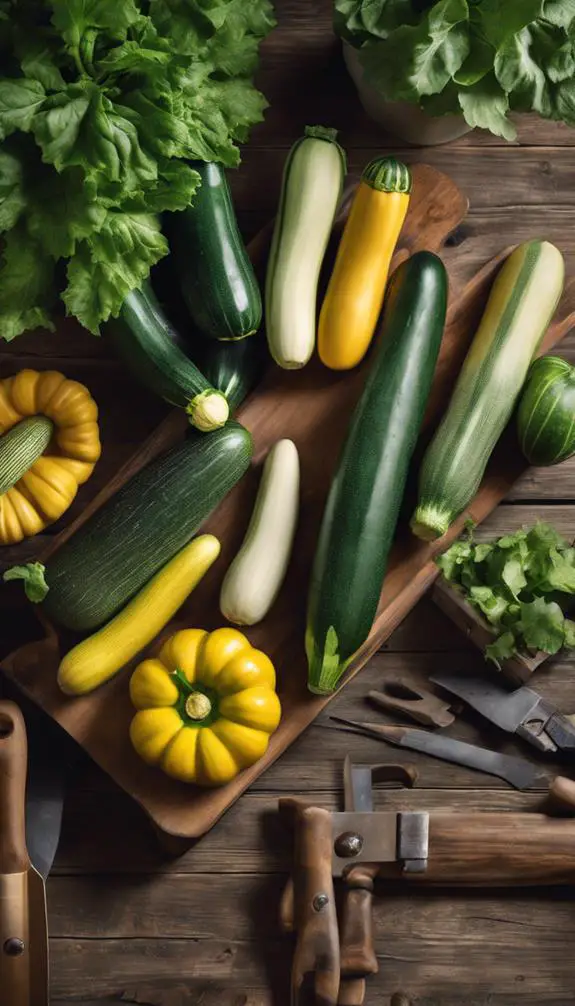
What characteristics do you want your zucchini to have? Do you prefer a specific shape, size, or color?
Perhaps you're looking for a unique flavor profile or texture. With numerous zucchini types to choose from, selecting the right variety is vital.
You can opt for the popular 'Black Beauty' or 'Round Courgette' for their high yields and tender flesh. If you're after a more exotic flavor, consider 'Costata' or 'Golden' varieties, which boast sweet and nutty undertones.
Some zucchinis, like 'Patty Pan', have a scalloped shape and a delicate, almost sweet flavor profile. Others, such as 'Cocozelle', have a more robust, earthy taste.
Preparing the Soil for Zucchini
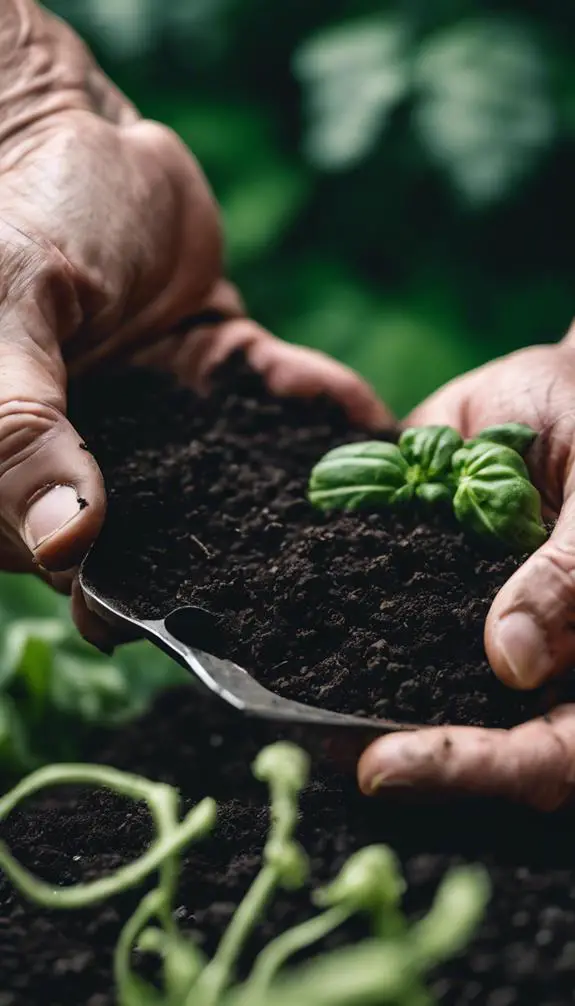
You're about to plant zucchini in a spot that's received adequate sunlight and has good air circulation.
Now, it's time to focus on preparing the soil. Conduct a soil test to determine the pH level and nutrient composition.
Zucchini prefers a slightly acidic to neutral soil pH, ranging from 6.0 to 7.0. If your soil is too acidic or alkaline, apply lime or sulfur to balance the pH.
Additionally, add organic matter like compost or well-rotted manure to improve soil structure and fertility. Mix in a 2-inch layer of compost or manure to a depth of 8-10 inches.
This will provide a nutrient-rich environment for your zucchini plants to thrive.
Sowing Zucchini Seeds Indoors
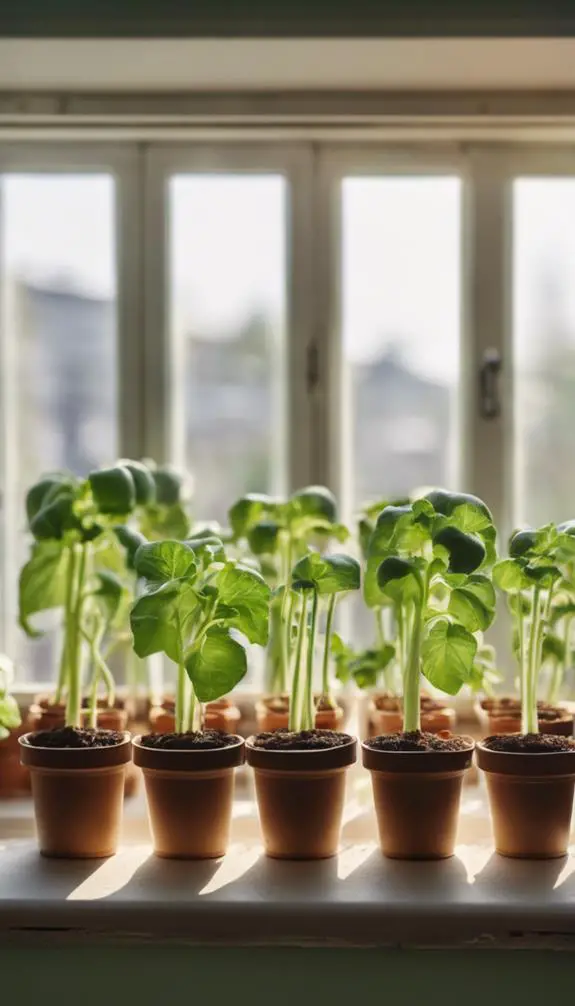
You'll want to start by filling your containers with a high-quality seed starting mix that's specifically designed for indoor germination.
Next, verify your soil temperature is between 70°F to 85°F (21°C to 30°C) for ideal germination, as zucchini seeds are sensitive to cold temperatures.
Seed Starting Mix
Prepare a high-quality seed starting mix specifically designed for indoor sowing, as this will give your zucchini seeds the best chance to germinate and thrive.
You want a mix that's well-draining, sterile, and has a neutral pH between 6.0 and 7.0. Avoid using garden soil from your outdoor garden, as it can compact and prevent proper drainage.
Seed quality matters, so choose fresh seeds with high germination rates. The mix should also be free of contaminants, such as fungal spores or bacteria, that can harm your seeds.
Soil Temperature Control
With indoor sowing, maintaining ideal soil temperature is crucial for successful germination of zucchini seeds.
You'll want to guarantee the soil temperature stays between 70°F to 85°F (21°C to 30°C) for peak germination. Use a soil probe to monitor temperature fluctuations, as even slight deviations can impact seed germination.
Avoid placing your seed starting trays near heating vents, radiators, or drafty windows, as these can cause temperature fluctuations.
Instead, choose a location with consistent temperatures, such as a heated propagation mat or a warm room.
Container Preparation Tips
Now that you've optimized your soil temperature for successful germination, it's time to focus on preparing the perfect container for sowing your zucchini seeds indoors.
Choose a container that's at least 6-8 inches deep and 8-10 inches wide to accommodate the zucchini's extensive root system.
Verify the container has adequate drainage holes, about 1-2 inches apart, to prevent waterlogged soil. You don't want your seeds to rot before they even germinate!
Additionally, consider using a container with a built-in water reservoir or a self-watering system to maintain consistent moisture levels.
A well-designed container will give your zucchini seeds the best possible start in life.
Transplanting Zucchini Seedlings Outdoors
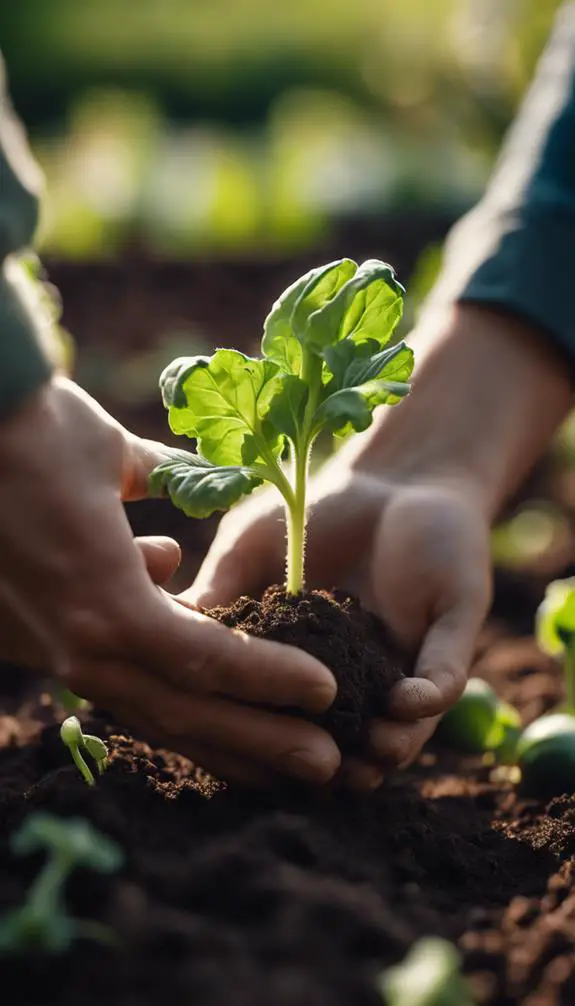
When transplanting zucchini seedlings outdoors, you'll need to choose a location with well-draining, fertile soil that's rich in organic matter, as this will support healthy growth and development.
You'll also want to select a spot that receives full sun and has adequate air circulation to prevent disease.
Before moving your seedlings outside, be sure to harden them off by gradually exposing them to outdoor conditions over the course of 7-10 days to prevent shock.
Choosing the Right Soil
Five to seven days before transplanting your zucchini seedlings outdoors, prepare the soil by loosening it to a depth of 12 to 18 inches to allow for proper root growth.
Next, test your soil's pH levels, which should ideally range from 6.0 to 6.8 for ideal zucchini growth. If necessary, adjust the pH by adding lime to raise it or elemental sulfur to lower it.
Additionally, evaluate the organic matter composition of your soil. Aim for a mix rich in compost, well-rotted manure, or aged peat moss to promote healthy microbial activity and nutrient cycling.
Selecting Ideal Location
With your well-prepared soil in place, turn your attention to selecting an ideal location for transplanting your zucchini seedlings outdoors.
Conduct a climate analysis to verify your location receives full sun (at least 6 hours of direct sunlight) and is protected from strong winds.
Perform a site assessment to identify any potential obstacles, such as shade from trees or buildings, and avoid areas with standing water or where water tends to collect.
Additionally, consider the proximity to a water source and the accessibility of the location for easy maintenance.
Hardening Off Process
Your zucchini seedlings have outgrown their indoor containers, and it's time to expose them to the outdoor environment.
To secure a successful shift, you'll need to harden them off. This 7-10 day process involves gradually introducing your seedlings to outdoor exposure, allowing them to undergo weather acclimation.
Start by moving them to a shaded outdoor location for 2-3 hours, then returning them indoors. Gradually increase their outdoor exposure over the next few days, monitoring for signs of stress.
Once they can tolerate full sun and wind, you're ready to transplant them into their final growing location. This careful process will help your zucchini seedlings thrive in their new outdoor environment.
Providing Optimal Sunlight Conditions
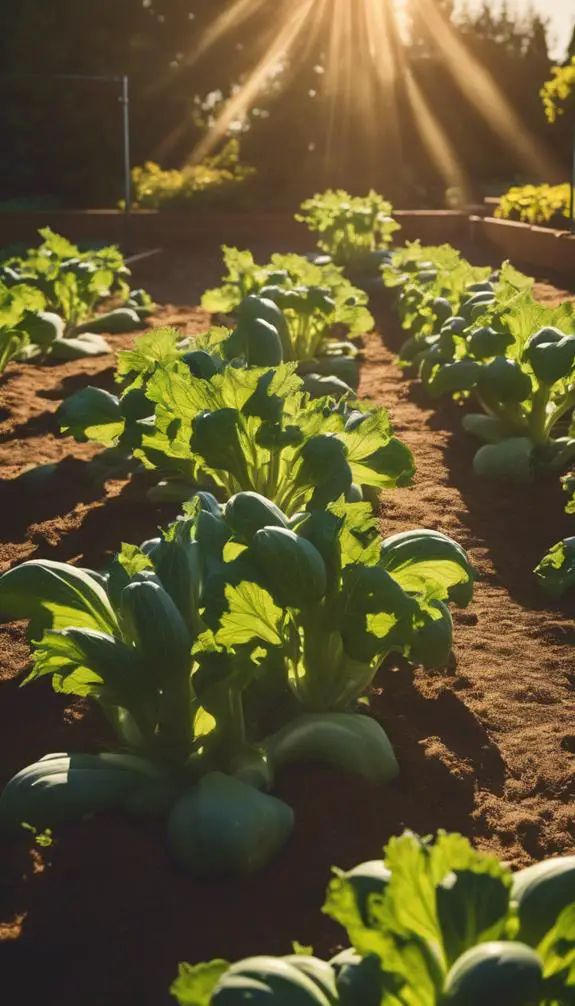
Throughout the growing season, direct sunlight pours down on your zucchini plants, fueling their rapid growth and development.
Sunlight is essential for photosynthesis, so it's vital to provide ideal sunlight conditions. For maximum growth, your zucchini plants require at least six hours of direct sunlight daily.
Ideally, they should receive morning sun and afternoon shade, especially in warmer climates. This balance prevents scorching and promotes healthy growth.
South-facing gardens are ideal, but if your garden receives intense afternoon sun, consider providing shade using a trellis or row covers.
Monitor your plants' response to sunlight and adjust their orientation or shading as needed. By fine-tuning sunlight conditions, you'll be rewarded with vigorous, productive zucchini plants.
Watering Zucchini Plants Correctly
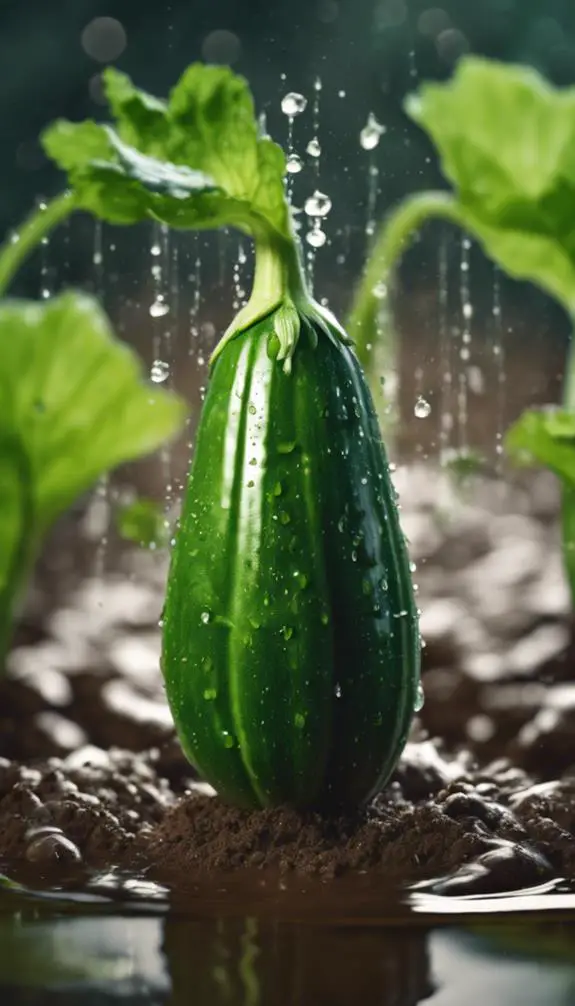
You'll want to monitor soil moisture levels daily, ensuring the top 6-8 inches of soil feel consistently moist but not waterlogged.
To achieve this, you'll need to water your zucchini plants when the top 2-3 inches of soil have dried out, which typically translates to every 2-3 days during hot summer weather.
Soil Moisture Levels
The soil's moisture levels play a critical role in the healthy development of zucchini plants, as inadequate or excessive watering can lead to stunted growth, reduced yields, and increased susceptibility to disease.
To guarantee ideal moisture levels, you'll need to monitor the soil regularly. You can do this by inserting your finger into the soil up to the knuckle or using advanced tools like soil sensors or moisture meters.
These devices provide accurate readings of the soil's moisture levels, helping you adjust your watering schedule accordingly. By maintaining the ideal moisture range of 60-70% for zucchini plants, you'll promote healthy root development, robust growth, and maximize yields.
Watering Frequency Tips
Your zucchini plant's watering schedule is crucial, as it directly impacts its growth and productivity.
To optimize watering frequency, you'll want to implement water conservation methods that guarantee your plants receive the right amount of moisture.
Check the soil moisture levels daily, and water only when the top 2-3 inches of soil feel dry to the touch.
For irrigation scheduling, aim to provide about 1-2 inches of water per week, either through rainfall or supplemental irrigation.
Consider using a drip irrigation system or soaker hose to deliver water directly to the roots, reducing evaporation and runoff.
Fertilizing for Maximum Growth

Fertilizer applications substantially impact zucchini's growth trajectory, and a well-planned regimen can mean the difference between a mediocre harvest and a bountiful one.
You'll want to provide your zucchini plants with essential nutrients at the right time to promote healthy growth. Create a fertilizer schedule that includes a balanced fertilizer (10-10-10 NPK) applied at planting time, followed by a high-phosphorus fertilizer (10-20-10 NPK) to promote fruiting.
Side-dress with a nitrogen-rich fertilizer (20-5-5 NPK) once the plants are about 12 inches tall. Additionally, consider adding organic matter like compost or well-rotted manure to provide micronutrients and improve soil structure.
Controlling Pests and Diseases Naturally
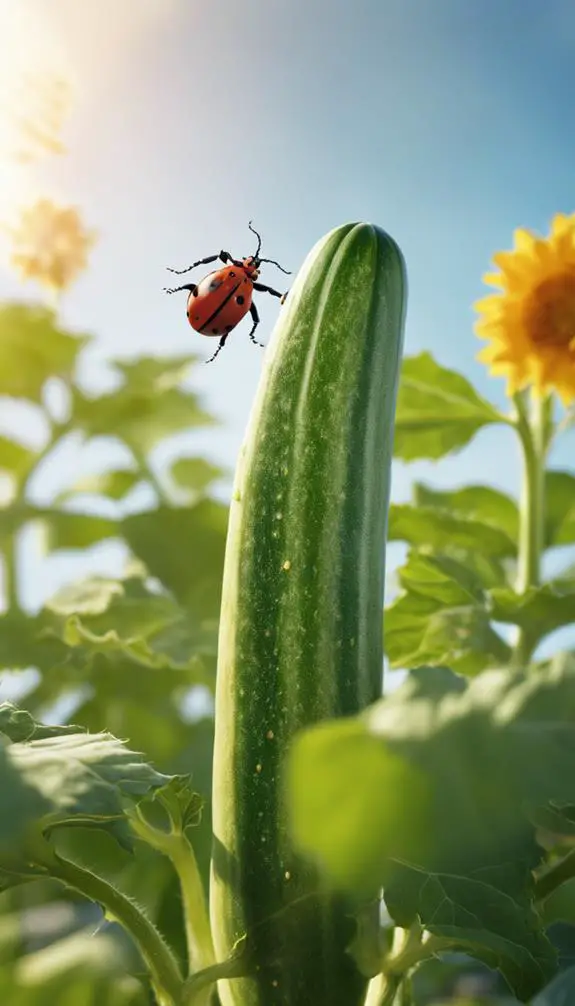
As you carefully tend to your zucchini plants, be vigilant for signs of pests and diseases that can quickly decimate your crop.
Keep an eye out for common pests like aphids, whiteflies, and squash bugs, as well as diseases like powdery mildew and fungal infections.
To control these issues naturally, try using neem oil, a natural pesticide that can be applied directly to affected areas.
Companion planting can also be an effective strategy, as certain plants like nasturtiums and marigolds repel pests that target zucchini.
Additionally, maintain good garden hygiene by removing weeds and debris, and ensuring adequate air circulation around your plants.
Pruning Zucchini Plants for Better Yield
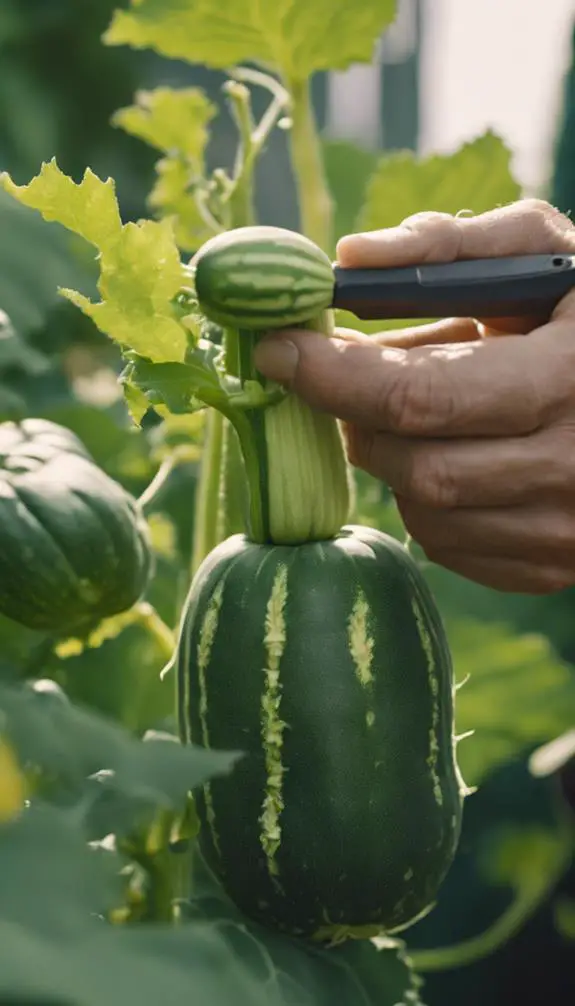
Pruning zucchini plants is a vital step in maximizing their yield.
You'll want to prune your zucchini plants regularly to promote healthy growth, increase fruit production, and encourage bushy development.
During summer pruning, remove any weak or spindly growth, as well as any leaves that are touching the ground to prevent disease.
This will allow air and light to circulate around the plant, promoting healthy growth.
You can also practice zucchini shaping by pruning the plant to encourage a more compact, bushy shape.
This will help the plant focus its energy on producing fruit rather than vines.
Training Zucchini Vines to Climb

With their natural tendency to spread out, zucchini vines can quickly overwhelm a garden bed if left unchecked.
To keep them under control, you'll need to provide support using vine training tips and trellis options. Install a sturdy trellis near the plant, and gently twine the vines around it as they grow. You can use twine, clips, or even old t-shirts to secure the vines to the trellis.
Make sure the trellis is at least 3-4 feet tall to accommodate the mature vine's height. As the plant grows, continue to guide the vines upwards, pruning any stray shoots that stray from the trellis. With proper training, your zucchini vines will climb upwards, maximizing space and promoting healthy growth.
Identifying and Harvesting Ripe Zucchini
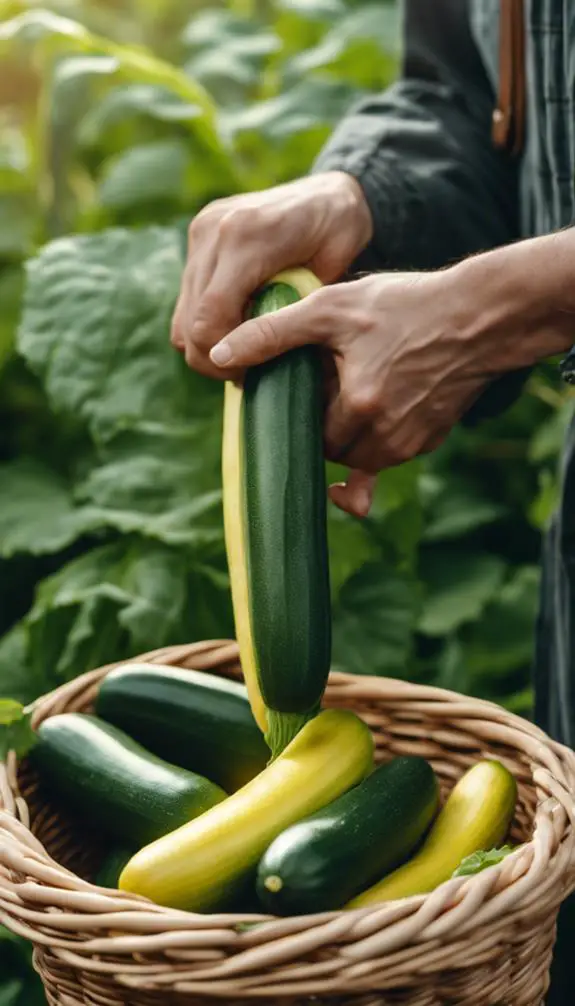
Your patience in cultivating zucchini vines will soon pay off, as the fruits of your labor begin to mature.
Now, it's vital to identify and harvest ripe zucchini to guarantee prime flavor and texture. Check your vines daily, as zucchini can grow rapidly.
Harvest when they're between 6-8 inches in length and about 1-2 inches in diameter. Ripe zucchini will be a deep green color, almost black, and have a slightly glossy sheen.
Avoid harvesting oversized zucchini, as they can be tough and seedy. Use scissors or a sharp knife to cut the stem, leaving about 1 inch of stem attached to the fruit.
Handle zucchini gently to prevent bruising, and enjoy your fresh, homegrown harvest!
Storing and Preserving Zucchini Harvest
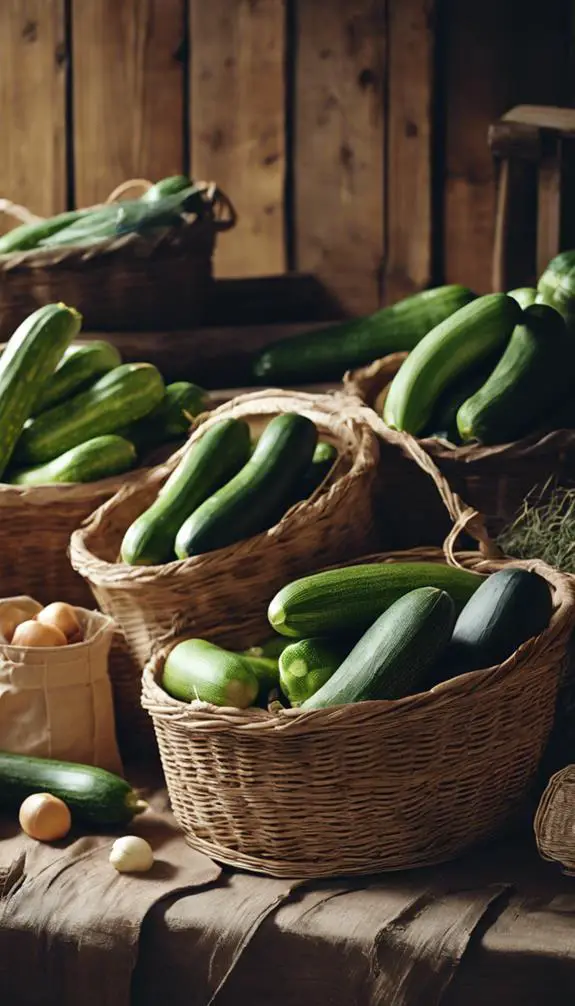
Beyond the excitement of harvesting fresh zucchini lies the crucial step of storing and preserving your bounty to enjoy throughout the year.
You've worked hard to grow a thriving crop, and now it's time to guarantee your zucchini stays fresh and flavorful for months to come.
For short-term storage, keep zucchini in a cool, dry place or refrigerate it to maintain its moisture.
For long-term preservation, consider zucchini freezing or dehydrating zucchini.
Freezing involves blanching and then freezing the zucchini to preserve its texture and flavor.
Dehydrating zucchini, on the other hand, removes the moisture, making it lightweight and easy to store.
Whichever method you choose, you'll be able to enjoy your homegrown zucchini all year round.
Troubleshooting Common Zucchini Issues
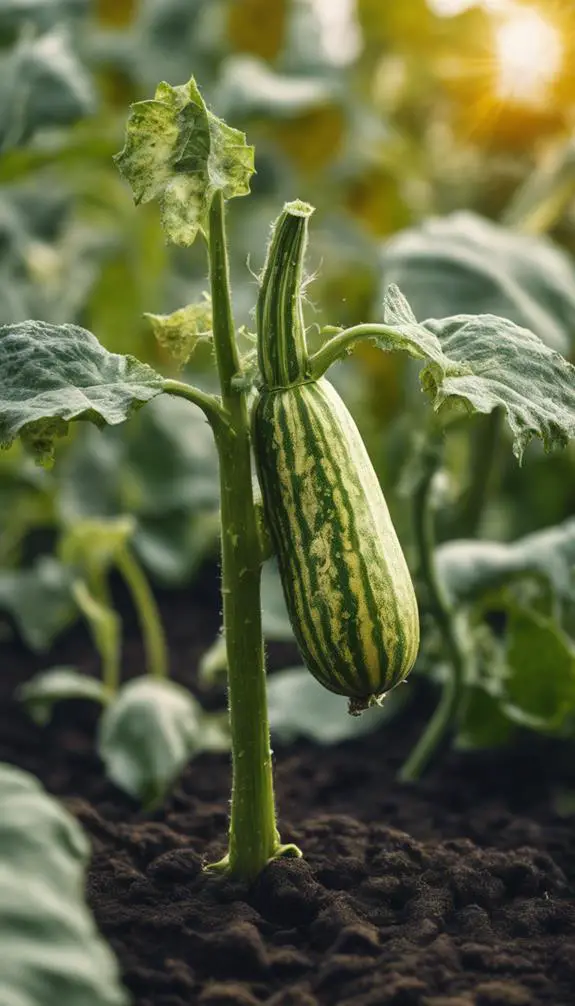
In the midst of a thriving zucchini harvest, it's not uncommon to encounter issues that can quickly turn your bounty into a bust.
You may notice zucchini discoloration, such as yellowing or browning, which can be caused by overwatering, underwatering, or exposure to extreme temperatures.
Zucchini wilting is another common issue, often resulting from root damage, inadequate watering, or pest infestations.
To address these problems, inspect your plants regularly, adjusting your watering schedule and pruning damaged leaves as needed.
Consider using organic pest control methods, such as neem oil or introducing beneficial insects, to combat infestations.
FAQs
Can I Grow Zucchini in Containers on My Apartment Balcony?
You can successfully grow zucchini in containers on your apartment balcony by selecting a large, well-draining pot (at least 5-gallons) with a trellis for support, and ensuring it receives full sun (6-8 hours of direct sunlight) and consistent watering.
How Do I Keep Squirrels From Eating My Zucchini Plants?
You'll want to outsmart those pesky squirrels by applying squirrel repellents, like predator urine or hot pepper sprays, and consider installing garden fencing, such as chicken wire or electric fencing, around your container garden to protect your zucchini plants.
Are Zucchini Plants Toxic to My Pets if They Ingest Them?
You should know that zucchini plants contain toxic compounds called cucurbitacins, which can cause vomiting, diarrhea, and lethargy in pets if ingested. Pet owners beware: keep your furry friends away from these plants to avoid potential harm.
Can I Use Zucchini Leaves in Cooking Like Basil or Spinach?
You can definitely use zucchini leaves in cooking, releasing leafy flavors similar to basil or spinach. Simply sauté them with garlic as you would sautéed greens, but be cautious of their slightly bitter taste and higher water content.
Will Zucchini Plants Grow Back if I Accidentally Cut Them Down?
You'll be relieved to know that zucchini plants can recover from accidental pruning; simply trim the damaged area, and new growth will emerge from the node, allowing your plant to regenerate and continue producing fruit.
Conclusion
By following these guidelines, you'll be well on your way to a bountiful zucchini harvest. Remember to monitor your plants' progress, address any issues promptly, and adjust your care routine as needed. With proper attention, your zucchini plants will thrive, providing you with a steady supply of fresh, nutritious fruit throughout the growing season.



